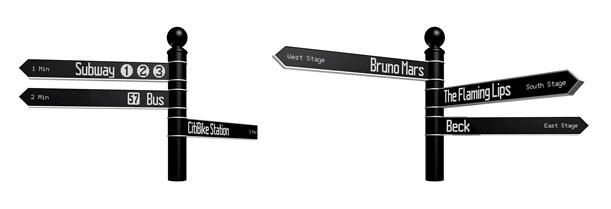A Sign For the Times: Digital Wayfinding Adapts to Your Needs
Design agency BREAKFAST is creating the street sign of the future
/https://tf-cmsv2-smithsonianmag-media.s3.amazonaws.com/filer/Design-Decoded-sign-for-times.jpg)
As previously mentioned on Design Decoded, New York City starting updating all their street signs last year with a new, more legible model designed specifically for transit. Well, they’re already obsolete. Design agency BREAKFAST have created what they’re describing as “the future of how people find where they’re headed next.” That seems a little vague, so let me clarify: they’re talking about a street sign. Futuristic street signs.
“Points,” as this high-tech sign is known, lives up to its name by indicating direction and distance. But it can do much more than that. The simple, familiar looking street sign conceals thousands of LED lights and an incredibly complex, incredibly quiet mechanism. When a passerby presses one of five buttons located on the signpost, Points comes alive – its three LED displays are rewritten while quietly whirring and whirling around to provide new information and point in the right direction.
It’s almost like a cartoon. One can imagine the Roadrunner zipping by at top speed, spinning the sign around to lead the coyote astray. But this is more controlled, more deliberate, and more high-tech. Like a Pixar cartoon of an anxious, ready-to-please street sign voiced by an autotuned Woody Allen.

The programmable control panel can change automatically over the course of a day, updating with more popular or relevant options. For example, at 8 a.m. a Points sign in a city might lead you to coffee or to the bus (noting arrival times), while at 8 p.m., that same sign might show you the way to the nearest cocktail or theater.
Points gathers content from the web and popular social media services, and can accommodate custom extensions. It can be a news ticker or a Twitter display. Why you would want a street sign to display tweets, I can only guess. But it sure looks cool. Like design firm BERG, who transformed twitter into a cuckoo clock, BREAKFAST are interested in combining network technology with real-world objects in a way that lets users physically interact with data. As they say on their website:
We’re officially living in the future….Some people call what we do “the internet of things” or “web 3.0.” In our opinion those sound a bit silly. We simply think of ourselves as inventors who take the amazingness of what can be done online and bring it into never-been-done-before devices and real world experiences. Everyday objects can be smarter, an ad campaign can be a circuit board, and a public space can react when it knows who you are.
It’s time to stop going on as though flying cars and telekinesis don’t exist, and time to make the real world as advanced as the virtual one that’s changed our lives in a single decade.
And while it could ostensibly work as a convenient, high-tech street sign in cities, it’s easy (and kind of fun) to imagine that these signs could also be used for more nefarious purposes. A wily Wile E. Coyote type or rogue Situationist might hack the city by reprogramming signs to purposely lead unsuspecting roadrunners and tourists astray down alleys or unexpected venues. Alas, such acts may simply be the dystopic trade-offs for “living in the future.”
With its need for constant power, a WiFi connection, and some serious weather-proofing (not to mention city proofing), Points currently seems targeted more toward commercial uses and can be rented out for events. BREAKFAST suggests that their system would be perfect for conventions, sporting events, theme parks, or festivals. Soon, the signs will begin appearing in big business and tourist destinations like Dubai and Las Vegas, a city with a particularly rich history of innovative and iconic signs. If Points proves to be a success, when you next come across two roads diverging, you may find yourself taking the one less tweeted.
/https://tf-cmsv2-smithsonianmag-media.s3.amazonaws.com/accounts/headshot/Jimmy-Stamp-240.jpg)


/https://tf-cmsv2-smithsonianmag-media.s3.amazonaws.com/accounts/headshot/Jimmy-Stamp-240.jpg)